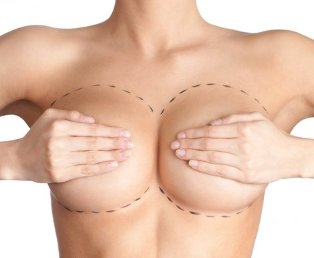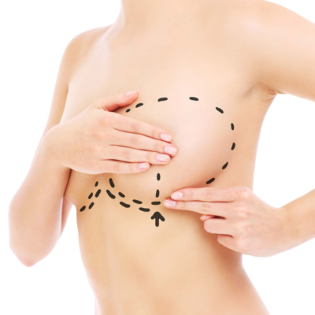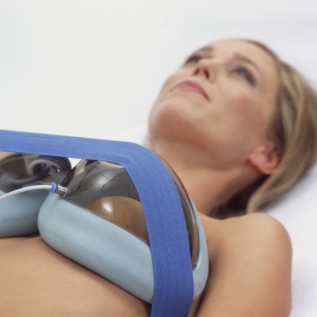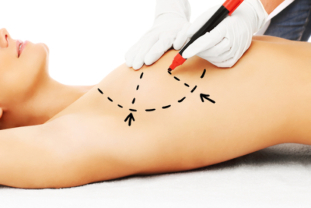
Lax breasts or sagging are aesthetic problems that many women worry about. She added doubts about herself and her sexuality.
If a woman is worried about this, she is embarrassed in front of her husband or boyfriend, then a breast lift should be tried.
This procedure should not be confused with implant breast augmentation. Lifting muscles are aimed at eliminating ptosis, bringing natural elasticity to the female breasts.
What is this procedure, what is it called?
Breast augmentation is called a mastopexy.This procedure involves reshaping the mammary glands, giving them natural elasticity and an attractive appearance without the use of implants. Operation is performed with minimal surgical intervention under local or general anesthesia.
The degree of ptosis plays an important role in its choice. There are 4 levels of the disease. Appropriate measurements are taken for an accurate diagnosis. The degree of sagging is determined by the distance from the breast fold to the nipple.
Help!Ptosis is stage 1, 2, 3, and 4 and is measured by the distance from the breast fold to the nipple. Flowing 1-2 cm down is not considered serious and refers to grade 1.
If the nipple is 8 cm or more lower than the breast fold, then place a level 4 pacifier. Here, surgeons have to remove a large amount of skin and adipose tissue, and without general anesthesiaDear, this would be impossible.

Reading
The skin of the chest is sensitive to any changes in the body. There is no natural muscle frame underneath to maintain its shape. Therefore, it is difficult to maintain the original shape throughout life. The reasons for its shape change are:
- Strong weight gain or loss.The stretched skin of the chest after weight loss loses its elasticity and laxity.
- Large bust size.Chest over 3 sizes sagging by natural weight.
- Changes in the hormonal background.Lack or excess of hormones that contribute to breast swelling or "stretch".
- Active. For example, when a malignant tumor is removed, the glands become asymmetric. In severe cases, the mammary gland becomes hollow and sagging.
- Age.The chest, without any supportive muscles, loses elasticity before the rest of the body.
- Bra fits well.Without adequate support, mammary glands will sag before their time.
- Breast-feeding.A milk-filled mammary gland can be 3-5 times larger. After the completion of breastfeeding, it returns to its original size, but not its shape.
- Birth defect.Breasts may not be developing properly from puberty. The only way is to fix the shape.
Another problem with sagging breasts is that it is often accompanied by stretch marks and sagging skin.
Contraindications and restrictions
Mastopexy implies surgical intervention in the body. Any activity has its own indications and contraindications. This type of operation is not specified in some cases:

- is pregnant or planning, as all results from the activity will disappear;
- less than 12 months after the end of hepatitis B, the degree to which the mammary glands need to recover from lactation;
- presence of tumors in the thoracic region;
- acute infectious disease;
- diabetes mellitus;
- renal failure;
- cardiovascular dystonia;
- under 18 years of age (parental consent and medical emergencies required);
- obesity, is the result of metabolic disorders and can cause complications after surgery.
Before deciding to use a mastopexy, it is important to consider the possible negative and positive consequences.
Views
Breast augmentation can be performed with or without surgery.In the first case, tissue resection is used in a variety of ways, and the second is to target deep layers of the skin. It should be noted that the non-surgical methods are best used to prevent ptosis or in its early stages. Operational interventions help to troubleshoot in more advanced cases.
Laparoscopy
Small incisions on the side of the breast.Endoscopes and instruments are introduced through them. The tissue is removed from the inside, so surgery after the scar has healed becomes invisible.
This is one of the most expensive mastopexy types. The success of this procedure depends on the qualifications and experience of the doctor performing it. But the results won't change for 10-15 years. Mastopexy endoscopy can eliminate ptosis of any severity.
Periareolar (circle)
During thissurgery, the doctor will remove excess tissue around the areola.In this way, you can not only tighten the mammary glands, but also change the diameter of the nipple. Traces after surgery and healing become invisible.
Among the downsides, can have an effect on breastfeeding. Also, it is only used with 1 and 2 deflections. After the surgery, some patients report a nipple sensitivity.
Vertical

Duringsurgery, the surgeon makes incisions above the breast and along the edges to raise the nipple.This method requires minimal intervention in the structure of the mammary gland and practically does not cause complications, maintaining the natural appearance of the breast. It can also help shrink nipples.
This method is used in the early stages of ptosis. It cannot be used if there is already a scar on the chest. Also, it will not help with serious sagging breasts.
Neo (T-shaped)
Recommended for severe soreness or discomfort of large breasts. During thesurgery, an inverted T-shaped or anchor-shaped incision is made in the chest.Next, the surgeon removes the excess tissue, and pulls the bottom up.
The manipulation has a marked aesthetic effect, can be repeated until the patient is satisfied with the results. The disadvantages include applying a large number of cuts. This increases the recovery time and could cause complications.
Laser
This is a relatively new type of breast lift. It is widely used in the West, but in our country there are a few clinics with necessary equipment.A laser can be used to lift and enlarge your chest.This does not require the use of a scalpel.
Laser lift is effective in the early stages of ptosis. It takes about 6 treatments to achieve the desired effect. They are taken over a period of at least 14 days. This procedure does not require anesthesia, as it is painless. In some cases, discomfort may occur.
Mesothreads
If the breast has previously lost elasticity and is causing internal discomfort for a woman, doctors recommend performing a stromal transplant. It leaves no trace on the skin and has no complications.
Located in the mammary gland, thefibers are gradually overgrown by fat tissue and creating a lifting effect.The threads continue to function for 6-8 months, after which they absorb completely and do not need to be removed.

Non-surgical method
Women with first degree sagging are advised to use non-surgical breast augmentation methods. They help restore skin elasticity and return the mammary glands to their former shape:
- Myostimulation - with the help of electrical impulses sent through the connected electrodes, skin elasticity is restored and stretch marks removed.
- Fat transplant - implants fat tissue from the abdomen and inner thighs to problem areas of the chest. Guaranteed 100% adipose tissue adhesion.
- Micro-electric current with serum - stimulates the active production of elastin and collagen, accelerates cell renewal, reduces stitches and stretch marks.
- Mesotherapy.
The choice of the enhancer is also influenced by the degree of elongation of the breast skin, its asymmetry and its size. The surgeon will evaluate the general condition and choose the safest and most effective option for each individual case.
Preparing for cosmetic surgery
Before being approved by the surgeon for breast augmentation,must consult other specialists: gynecologists, therapists, mammary gynecologists and doctorsanesthesia.You will also need to pass some tests:
- general and biochemical blood tests;
- blood test to look for diabetes;
- general urine analysis;
- analysis of hepatitis, HIV, syphilis;
- Electrocardiogram;
- Breast ultrasound; mammography
- ;
- fluorography.
For 14 days before surgery and for the same period thereafter, you must not smoke, drink alcohol, or take any drugs that affect the density of blood, including oral contraceptives. You should also give up intense physical activity. Right before surgery, not to eat food 12 hours before surgery. You can drink tea or water.
How is it done, is it dangerous?

How is the operation performed?Mastopexy safe.It starts with a chest mark. The surgeon marks the incision sites and areas of skin to be removed with a marker. Then the patient was under anesthesia. It can be of several types:
- intravenously;
- inhale;
- locally.
Stages of mastopexy:
- surgeons make incisions along markers;
- further produces the end result and cuts excess skin and adipose tissue;
- if necessary, the surgeon reduces the circumference of the nipple;
- Then, sutures and antibacterial bandages, drain (you can read more about stitches and how long they heal after surgery).
Uptime from 1, 5 to 3 hours.
What happens in the postoperative period?
- The patient regained consciousness almost immediately after surgery.Chest pain begins when we recover from anesthesia. The doctor performing the surgery should advise on the pain relievers and antibiotics to be used in the postoperative period.
- 3 days after mastopexy administration, the patient was observed in the hospital.If no complications arise, she will be discharged. The doctor should evaluate the main result, namely whether the stitches have started to fit and whether there is an asymmetry. After one week, the stitches are removed.
- Edema was observed during the first week after surgery.The chest looks stone. During the first month the swelling persists, possibly with bruising. After 1-3 months, they completely disappear, you can evaluate the results. During this time, the suture will heal completely, edema and hematoma will gradually decrease.
- Must wear corrective underwear for the first six months, will help keep fit, use ointment to speed skin regeneration. This will help get through the recovery period faster.
- Also, for 6 months after surgery, you must not go to the bathroom, sauna,so as not to infect your open suture. Not allowed to go to the gym and lift weights - this contributes to misalignment of the seams.
Patients who decide to treat mastopexy should also be aware of possible complications. These include pain in the mammary gland area, bruising and hematoma, swelling in the incision, tissue inflammation and loss of sensitivity.
Before and After Image

See more in the photo, you will see how big breasts look before and after lifting.
Cost of the procedure
The cost of the service depends on the type of surgery, the qualifications of the surgeon and staff, and the condition of the clinic. The price also includes a training program, purchase of edited lingerie, patches, anesthesia.
Mastopexy is an opportunity for all women to re-feel their gender and attractiveness. Before making a serious decision, however, you should research the information about the activity, compare the positive aspects and possible risks, and then make a final decision.
Mammography is a type of surgery aimed at adjusting the shape and size of a breast. Specialist changes the contour, volume of the mammary glands, the shape of the nipples and areola.




























